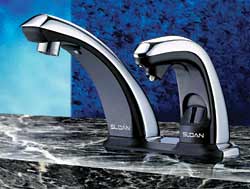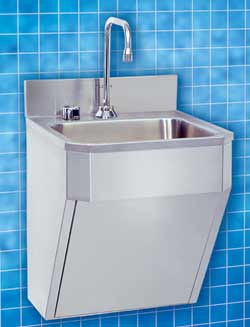Factors For Achieving Water Conservation Excellence:
The Hygiene Benefit
When evaluating water conservation strategies, the architect should consider factors such as the type of facility and the number of people who will have access to specific restrooms. One important benefit from sensor technology is hygiene, which directly affects the building in terms of tenant satisfaction and occupancy rates. Often, hygiene is considered separately instead of a by-product of product specification. In actuality, they are related.
|
Touchless, sensor-operated fixtures, for example, are the best solution to providing a hygienic atmosphere in healthcare and educational facilities because plumbing fixtures operate in damp environments, which are prime breeding grounds for bacteria. As pointed out, LEED allows for a 20% reduction in lavatory and sink use durations when sensor controls are installed. It also helps meet the intent of the Indoor Environmental Quality (IEQ) section of LEED-NC, which seeks to protect building occupants from harmful environmental conditions, and improve comfort and well being. Certainly, preventing the spread of germs by using sensor controls helps to promote hygiene and all of hygiene's subsequent benefits (more productivity, fewer sick days, etc.).
The Centers for Disease Control and Prevention (CDC) reports that hand washing is the single most important means of preventing the spread of germs. It is the first line of defense for infectious diseases, including respiratory infections and gastrointestinal disorders, among others. In fact, after using a public restroom, a single hand can have a bacteria population of 200 million, according to the CDC. Nevertheless, it takes just seconds to re-contaminate after washing by touching dirty faucets, soap dispensers and then finally, towel dispensers-something the general public is increasingly aware of now.
|
The use of touchless faucets is so important (and logical) to ensuring a hygienic atmosphere that it is the single design specification for scrub sinks for operating rooms, according to the Association of PeriOperative Registered Nurses (AORN), the leader and expert on patient safety in surgical settings. "In general, there is only one specific feature we recommend for surgical scrub sinks: that it allows hands-free operation," says Ramona Conner, RN, MSN, CNOR.
Sensor-operated faucets also increase hygiene in public and semi-private restrooms, such as in hospital rooms. That's because the dirtiest area in the bathroom, as far as germs are concerned, is the sink itself. A research study on public restrooms titled "Enteric Bacterial Contamination of Public Restrooms" showed that total coliforms (aerobic bacteria found in the colon or feces) were present on 17.3% of the 248 surface samples taken from hospitals. Sink drain surfaces resulted in positive samples of coliforms 80% of the time, followed by the rim of the sink 20% and then the area under the soap dispenser 10%. The reason for this is that when a person washes, bacteria are shed from the hands and collect in the sink area.











